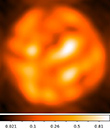Universe at high angular resolution at visible wavelengths
If, at visible wavelengths, existing interferometers resolve some bright stars and near-by galaxies, the universe at high angular resolution is still to be discovered: even with the most powerful existing instruments, nearby stellar systems and distant galaxies appear as point sources and not as the complex objects they really are. In other words, they receive the light that these objects emit but they don’t “see” fine details. Consequently, our understanding of physical phenomena in these astrophysical objects is due to our physical modelling obtained from their light spectrum and variability. Direct and spectrally resolved imaging made possible – at optical and infrared wavelengths – by instruments such as hypertelescopes will give us access to much finer and more detailed understanding of these objects and will contribute to elucidate the way they function.
Stars at high angular resolution
The brightest unresolved objects we detect are stars. Stellar surface brightness distributions can sometimes be predicted without recurring to direct imaging techniques at high angular resolution, but stellar atmospheres may have convection zones, mechanically driven matter flows, radiation driven winds, accretion, and other complex phenomena that are difficult to investigate without the recourse to these techniques. The possibility to observe these phenomena in the visible and infrared is strongly suggested by the observation of resolved surface structures at these wavelengths. The surface of only a few bright stars has been observed at visible wavelengths (Monnier et al., 2007). Observation of a large number of stars by direct imaging at high angular resolution at visible wavelengths would greatly improve our understanding of these phenomena.

Numerical simulation of the image of Betelgeuse observed
with a ground-based hypertelescope containing 100 mirrors
in a 30m meta-aperture.
Multiple stars at HAR
Many stars are multiple systems orbiting around their gravitational centre. The observation of their movement is rich in physical information, for example about the mass of its components. Observation at HAR of light sources emitted by a star on its partner would allow detecting the accretion disc of its partner – which could be a black hole.
Exo-planets at HAR
Many stars have planetary systems orbiting around them. Several methods are currently able to detect these exo-planets and provide a mean to measure their mass (Tennebaum et al., 2012). Nevertheless, because of the limited angular resolution and the lack of contrast of existing instruments, there are only a few images of extra-solar planets and none of them show resolved details. With a high angular resolution instrument such as a hypertelescope, an image of a planet transit could be observed without the need for coronography. Such observations are particularly interesting since they provide appreciable information on the planet’s atmosphere, especially with spectroscopy (Tanga, Widemann, Sicardy, 2011). Provided there is also sufficient contrast, an image of their surface could provide evidence of regions that change colour with the seasons, and therefore indicate evidence for life.

Numerical simulation of the image of an Exo-Earth located at ten light-years,
viewed with a spatial hypertelescope with a 100km meta-aperture.
Galaxies at HAR
Galaxies typically contain a hundred billion stars. Only nearby galaxies are resolved. The angular resolution of current interferometers can only resolve in stars very bright galaxies (Labeyrie, Lipson, Nisenson, 2006). Measurements of the angular diameter of young galaxies (therefore distant and faint) would contribute to the understanding of their formation. Even more, direct images of distant (faint) active galaxies may enable us to view matter accreting into massive black holes as well as the jets of expelled matter and circum-nuclear star-forming regions. However, as is the case with stellar astrophysics, simple angular diameter measurements would already provide new understanding of these objects.
References :
- A. Labeyrie, S. G. Lipson, and Nisenson. An Introduction to Optical Stellar Interferometry. Cambridge University Press, June 2006.
- J. D. Monnier, M. Zhao, E. Pedretti, et al. Imaging the surface of Altair. Science, vol. 317:342, 2007.
- P. Tanga, T. Widemann, B. Sicardy. The aureole of Venus: light refraction in the mesosphere during the solar transit of June 6, 2004. EPSC-DPS Joint Meeting, 2011.
- P. Tenenbaum, J.M. Jenkins, S. Seader, et al. Detection of potential transit signals in the first twelve quarters of Kepler Mission Data. ArXiv:1212.2915, 2012.
Additional Reference :
- P.D. Nunez. Towards optical intensity interferometry for high angular resolution stellar astrophysics. PhD. Thesis, University of Utah, 2012.


